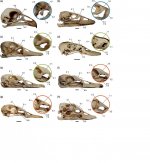albertonykus
Well-known member
De Mendoza, R.S., R.O. Gómez, and C.P. Tambussi (2020)
The lacrimal/ectethmoid region of waterfowl (Aves, Anseriformes): phylogenetic signal and major evolutionary patterns
Journal of Morphology (advance online publication)
doi: 10.1002/jmor.21265
https://onlinelibrary.wiley.com/doi/full/10.1002/jmor.21265
Waterfowl (Aves, Anseriformes) constitute an ancient global radiation, and understanding the pattern and timing of their evolution requires a well‐corroborated phylogeny including extant species and fossils. Following the molecular advances in avian systematics, however, morphology has often been held as misleading, yet congruence with molecular data has been shown to vary considerably among different skeletal parts. Here, we explore phylogenetic signal in discrete characters of the lacrimal/ectethmoid region of waterfowl, which is highly variable among species and constitutes a rich source of data. We do so by combining cladistic and multivariate approaches, and using phylogenetic comparative methods. We quantitatively recognize three major morphological types among lacrimal bones, and discuss homoplasy and potential synapomorphies of major clades using a molecular backbone tree. Our results clearly indicate that the lacrimal bone carries substantial phylogenetic signal and could be of systematic value at different levels of the phylogeny of waterfowl, feeding the exploration of other regions of the skull with this combined approach.
The lacrimal/ectethmoid region of waterfowl (Aves, Anseriformes): phylogenetic signal and major evolutionary patterns
Journal of Morphology (advance online publication)
doi: 10.1002/jmor.21265
https://onlinelibrary.wiley.com/doi/full/10.1002/jmor.21265
Waterfowl (Aves, Anseriformes) constitute an ancient global radiation, and understanding the pattern and timing of their evolution requires a well‐corroborated phylogeny including extant species and fossils. Following the molecular advances in avian systematics, however, morphology has often been held as misleading, yet congruence with molecular data has been shown to vary considerably among different skeletal parts. Here, we explore phylogenetic signal in discrete characters of the lacrimal/ectethmoid region of waterfowl, which is highly variable among species and constitutes a rich source of data. We do so by combining cladistic and multivariate approaches, and using phylogenetic comparative methods. We quantitatively recognize three major morphological types among lacrimal bones, and discuss homoplasy and potential synapomorphies of major clades using a molecular backbone tree. Our results clearly indicate that the lacrimal bone carries substantial phylogenetic signal and could be of systematic value at different levels of the phylogeny of waterfowl, feeding the exploration of other regions of the skull with this combined approach.





